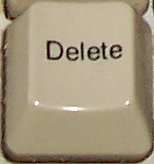Delete key

The delete key is a key on most computer keyboards which typically is used to delete either (in text mode) the character ahead of or beneath the cursor, or (in GUI mode) the currently-selected object.
Position and labelling on keyboards
The key appears on English-language IBM-compatible PC keyboards labeled as Delete or Del, sometimes accompanied by a crossed-out right-arrow symbol.[1][2] However, sometimes the key labelled Delete performs the Backspace function instead, for example on some Apple keyboards.[3]
In other cases, the Delete key is in its original IBM notebook position of above and to the right of the Backspace key. Many laptops add rows of smaller keys above the Function key line to add keys on a non-standard size keyboard. On this row of smaller keys, the position of the Delete key is positioned at or near the right-hand end. On Apple's line of laptops (e.g. the MacBook and MacBook Pro), the forward delete function can be achieved using the Fn+← Backspace key combination.
The Delete key is typically smaller and less-conveniently located than the Backspace key, and on keyboards where space is limited, for example those omitting the numeric keypad or virtual keyboards on mobile devices, it is often omitted altogether.
Uses
When struck on a computer keyboard during text or command editing, the delete key (Delete or Del, known less ambiguously as forward delete, discards the character ahead of the cursor's position, moving all following characters one position "back" towards the freed letterspace. The key is also used by many GUI applications to request deletion of the currently-selected object, for example a file in a file browser or a block of text in a word processor.
The delete key often works as a generic command to remove a selected object, such as an image embedded in a document (on Apple Keyboards, both the forward delete key and the delete (backspace) key have the same effect when pressed while an object is selected).[1]
On Unix-like systems, the delete key is usually mapped to ESC[3~ which is the VT220 escape code for the "delete character" key.[4]
The delete key, on many modern motherboards, also functions to open the BIOS setup screen when pressed after starting the computer.
In GUI applications where the Delete key is enabled, especially in file browsers, pressing it does not necessarily immediately delete the selected object, but often a confirmation dialog box will appear to allow the user to cancel the deletion, or the object may instead be silently moved to a "trash folder" or equivalent, so that it can be recovered later. In other GUI contexts, the Undo function can often reverse a deletion.
Alternative Key Mapping
As many Apple keyboards lack a dedicated key for the forward delete function, Mac users wishing to have a dedicated forward delete key can reassign the forward-delete function to a different key using various third-party apps, such as DoubleCommand or PowerKey. For example, installing and enabling the DoubleCommand app allows the user to use the Backslash, Capslock or numeric keypad ↵ Enter keys as a forward delete key.[5]
See also
References
- 1 2 "Forward Delete (Fwd Del)". Apple Human Interface Guidelines.
- ↑ "Image of the keyboard layout of a full-sized aluminum Apple keyboard". Retrieved 2012-07-31.
- ↑ Matthew Rogers (2011-05-18). "The Mac OS X Delete Key: It Goes Both Ways". Lifehacker. Retrieved 2015-09-21.
- ↑ "9.8 Keyboard configuration". Debian Policy Manual.
- ↑ Soundforge DoubleCommand download page, http://doublecommand.sourceforge.net/features.html Accessed 2016-11-10
| IBM PC keyboard (Windows, US layout) | ||||||||||||||||||||||||
|---|---|---|---|---|---|---|---|---|---|---|---|---|---|---|---|---|---|---|---|---|---|---|---|---|
| Esc | F1 | F2 | F3 | F4 | F5 | F6 | F7 | F8 | F9 | F10 | F11 | F12 | PrtScn/ SysRq |
Scroll Lock |
Pause/ Break |
|||||||||
 |
Insert | Home | PgUp | Num Lock |
∕ | ∗ | − | |||||||||||||||||
| Delete | End | PgDn | 7 | 8 | 9 | + | ||||||||||||||||||
| 4 | 5 | 6 | ||||||||||||||||||||||
| ↑ | 1 | 2 | 3 | Enter | ||||||||||||||||||||
| ← | ↓ | → | 0 Ins |
. Del | ||||||||||||||||||||